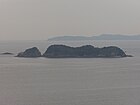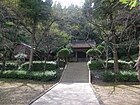Hidden Christian Sites in the Nagasaki Region
| Hidden Christian Sites in the Nagasaki Region | |
|---|---|
|
UNESCO world heritage |
|

|
|
| Nakaenoshima Island |
|
| National territory: |
|
| Type: | Culture |
| Criteria : | (iii) |
| Reference No .: | 1495 |
| UNESCO region : | Asia |
| History of enrollment | |
| Enrollment: | 2018 ( session 42 ) |

The Hidden Christian Sites in the Nagasaki Region were proposed as a serial UNESCO World Heritage Site in 2018 and added to the list on June 30, 2018.
The churches and Christian sites in Nagasaki had been on the tentative list since 2007 . When registered in 2007, 28 historic buildings, mostly churches, were named, while the sites proposed in 2018 focus more on the life of the Christian population. There are ten villages or islands, a ruined castle and a cathedral, located in the prefectures of Nagasaki and Kumamoto in the north-west of the Japanese archipelago .
Phases of the Christian History of Japan
The twelve sites proposed as World Heritage were selected in such a way that they can represent different phases of Japanese church history :
- The oldest site ( Hara Castle ) represents a key event that led to the ban on the Christian religion in Japan, namely the Shimabara Rebellion .
- Five sites illustrate the different religious traditions developed by the hidden Christians ( Kakure Kirishitan ).
- Four sites illustrate the migration strategies of the Kakure Kirishitan .
- A site and a monument ( Cathedral of Oura ) illustrate the phase of tolerance and legalization of Christianity in Japan.
World Heritage Candidate
Just being registered on the Japanese tentative list attracted attention to the Christian sites, both locally, where Christians are a small minority, as well as nationally and worldwide. The initiative did not initially come from Nagasaki Prefecture, but from monument conservationists who were concerned about the preservation of the church buildings in the face of dwindling communities. The Catholic Archdiocese of Nagasaki opened a pilgrims office in 2007. The Japanese Tourism Association developed the concept of a pilgrimage route that connected numerous Christian sites in the Nagasaki region, including churches, sites of martyrdom, cemeteries and museums. In other Christian places, the traditions from the time of persecution were collected.
In February 2016, Japan withdrew the application for World Heritage status after ICOMOS criticized the explanation of the individual sites as inadequate. ICOMOS suggested a stronger focus on the period of Christian persecution. A revised and shortened list of world heritage sites was approved by UNESCO in summer 2018.
List (as of 2018)
| image | object | description |
|---|---|---|

|
Hara castle ruins (archaeological site) | More than 20,000 rebellious farmers led by Amakusa Shiro used the abandoned Hara Castle as a military base during the Shimabara rebellion 1637–1638. The uprising had social causes, but also took on features of religious conflict, since many of the rebels were Christians. As a defensive system, Hara still had medieval features (walls made of hardened mud) on the one hand, and an early modern stone wall on the other.
During excavations, numerous small Christian finds came to light: irregularly shaped crosses which the besieged apparently made from bullets, medals, rosary beads. |

|
Kasuga Village and Yasumandake Mountain on Hirado Island | Catholic graves dating from the early days of Christian missions in Japan have been found in the village of Kasuga . Christian cult objects were kept in some houses in the village.
The Kakure Kirishitan lived their faith, among other things, by visiting places in nature that they considered sacred. One such place was Mount Yasumandake, also revered by Buddhists and Shintoists . |

|
Nakaenoshima Island | Many Christians were executed on the uninhabited island between Hirado and Ikitsuki. Nakaenoshima was therefore venerated as a holy place by the Kakure Kirishitan . Among other things, they fetched water from here for baptisms and other rituals. |

|
Sakitsu village on Shimoshima Island in Amakusa | In the fishing village of Sakitsu, the Kakure Kirishitan worshiped the traditional gods of luck Daikokuten and Ebisu as Deus (the god of Christians) and Haliotis shells as the symbol of the Virgin Mary. Particularly noteworthy are the house of the Christian community leader ( mizukata ) and the house of the mayor, in which the fumi-e took place: people suspected of Christianity had to step on Christian symbols in order to distance themselves from their religion.
The Shinto shrine Sakitsusuwa is located near the village. Christians from Sakitsu Village used it as a place of prayer during the period of persecution. In 1805 a group was interrogated who claimed to be reciting anmen riyusu ( Amen Jesus or Amen Deus ) at this shrine |

|
Shitsu village in Sotome | In this village, the Kakure Kirishitan managed to hide Christian cult images in several houses. Isolated from the Catholic world church, they continued to follow the liturgical calendar and passed on the catechism.
After the persecution ended, most of them joined the Catholic parish and built a church on a hill overlooking the town. This church has separate entrances for men and women; the architecture is adapted to the stormy winds. |

|
Ono village in Sotome | In this village, the Kakure Kirishitan survived by posing as Shintoists and Buddhists. They worshiped the usual Shinto shrines, where they set up their own cult images, in front of which they prayed. The church with its remarkable architecture was built after the end of the period of persecution. |

|
Villages on Kuroshima Island | On this island the Kakure Kirishitan founded new settlements in previously uninhabited areas. The pastures laid out by the Christian settlers can be seen in the landscape. With the tacit consent of the Buddhist population already resident there, they erected a (no longer preserved) statue of Maria Kannon in the Kozenji Temple.
Before building their own church, the Christians of Kuroshima met for prayer in the house of their chief ( mizukata ). The neo-Romanesque church was completed in 1902, the altar area is covered with Arita porcelain tiles. |

|
Ruins of villages on Nozaki island | Kakure Kirishitan from Sotome Island settled on this mountainous island, which is considered sacred by Shintoists, in the 19th century . Outwardly, they practiced Shinto, based on the Okinokojima Shrine. The terraced cultivated land from the time of the Christian settlements is recognizable in the landscape. |

|
Villages on Kashiragashima Island | Traditionally, people with infectious diseases have been isolated on this remote island. This made it suitable as a retreat for the Kakure Kirishitan . The Christian cemetery and the grave of a Buddhist who organized and supported the Christian settlement on the island should be emphasized here. |

|
Villages on Hisaka Island | Here Christians and Buddhists settled in different villages, but cooperated in fishing and agriculture. The rice fields are still there, the location of Rokuroba is reminiscent of fishing. |

|
Egami village on Naru island | Particularly rich fisheries yields in 1918 made it possible for the Christian community to build this wooden church.
The region is currently suffering from severe population loss. In the church there is only a service once a month, in which three people take part. The “dignified” demolition of the wooden church has already been considered in order to prevent it from falling apart. |

|
Oura Cathedral ( Basilica of the Twenty-Six Holy Martyrs ) | It was here in 1865 that the first contact between Japanese secret Christians and French missionaries took place after 220 years of isolation. |
Justification of the request
The Japanese government, as the applicant, sees the Hidden Christian Sites in the Nagasaki region as unique examples that believers of a persecuted religion survived over two centuries not only by retreating to remote areas, but by camouflaging themselves socially as Shintoists or Buddhists. ICOMOS agrees with this assessment and sees peculiarities in the culture of the Kakure Kirishitan that justify an inscription as a world cultural heritage (criterion iii).
Entry in the list
On June 30, 2018, the World Heritage "Hidden Christian Sites in the Nagasaki Region" was added to the list.
Web links
- Entry on the website of the UNESCO World Heritage Center on tentative lists.
- Evaluations of Nominations of Cultural and Mixed Properties. ICOMOS report for the World Heritage Committee 42nd ordinary session, Manama, 24 June - 4 July 2018 , pp. 113–123.
- Own homepage: Hidden Christian Sites in the Nagasaki Region
- Pilgrimage route: Oratio
- Hidden Christian Sites in the Nagasaki Region Information Center (as of 2016)
literature
- Nagasaki Prefecture: Candidate for World Heritage: Churches and Christian Sites in Nagasaki
- Ayako Fukushima: Demolition of Tangible Properties as an Intangible Practice . In: Laurent Bourdeau, Maria Gravari-Barbas (Ed.): World Heritage, Tourism and Identity: Inscription and Co-production . Routledge, 2016. ISBN 978-1-4094-7058-8 . Pp. 199-216.
- Tinka Delakorda Kawashima: Pilgrimage, Cultural Landscape and Tourism in the Heritization of Churches and Christian Sites in Nagasaki . In: Razaq Raj, Kevin A Griffin (Eds.): Conflicts, Religion and Culture in Tourism . CAB International 2017, ISBN 9781786390660 . Pp. 69-81.
- Beate Löffler: Foreign and Own: Christian sacred buildings in Japan since 1853 . Frank & Timme, Berlin 2011. ISBN 978-3-86596-358-1 .
Individual evidence
- ↑ Entry in the list with the number 1495 , accessed on June 30, 2018.
- ↑ Tinka Delakorda Kawashima: Pilgrimage . S. 72 .
- ↑ Nagasaki's Oura Church among Christian sites eyed for UNESCO Heritage listing. In: The Japan Times. July 25, 2016. Retrieved June 24, 2018 .
- ^ Stone-walled castles. In: Oratio. Retrieved June 24, 2018 .
- ^ The cause of the rebellion. In: Oratio. Retrieved June 24, 2018 .
- ↑ Formation of the tradition of continuing the Christian faith. In: Hidden Christian Sites in the Nagasaki Region. Retrieved June 24, 2018 .
- ↑ Sakitsusuwa shrine. In: Oratio. Retrieved June 24, 2018 .
- ↑ Ayako Fukushima: Demolition of Tangible Properties . S. 201.210 .
- ↑ Entry in the list with the number 1495 , accessed on June 30, 2018.

